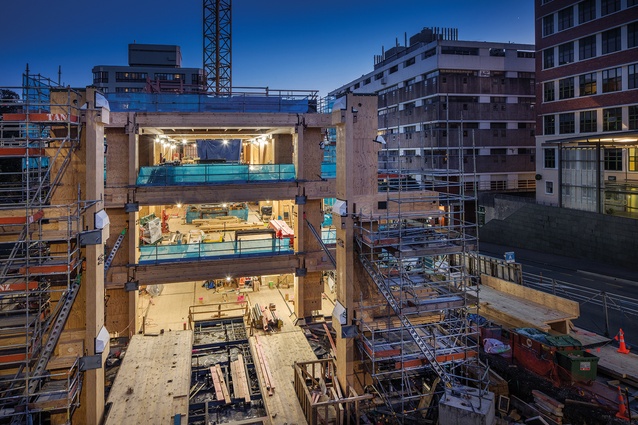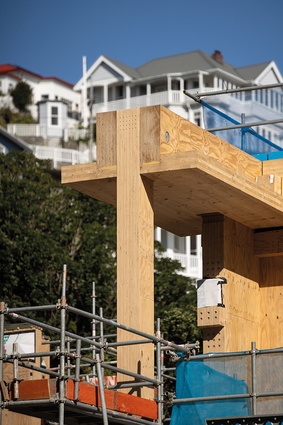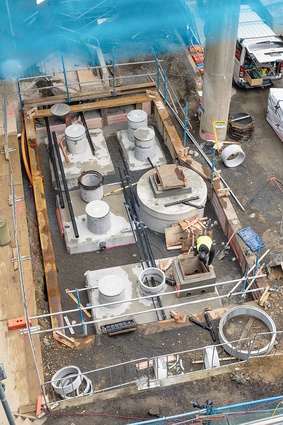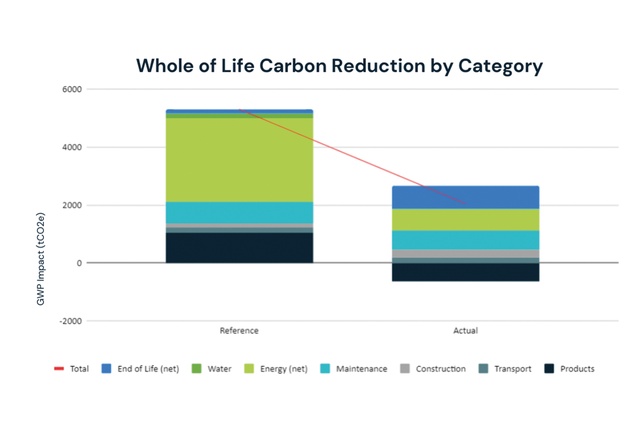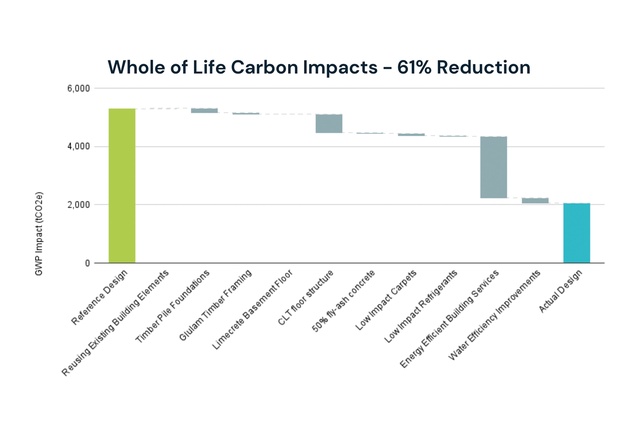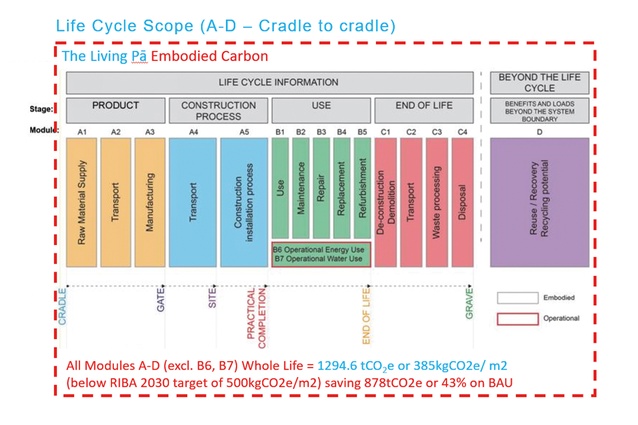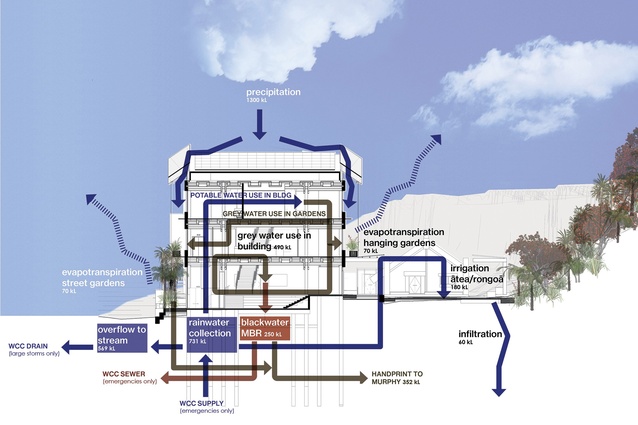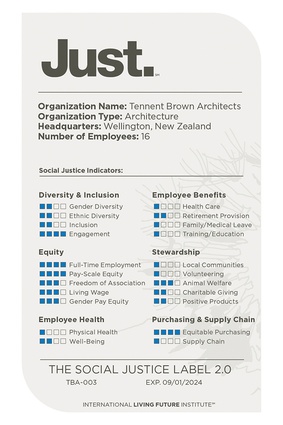Bringing the change
Ewan Brown discusses the Living Pā at Te Herenga Waka Victoria University of Wellington, the latest in a list of Tennent Brown projects implementing the Living Building Challenge, the world’s highest green construction standards.
In the heart of Wellington, our team at Tennent Brown is helping a new kind of building rise up through the Kelburn campus of Te Herenga Waka Victoria University. The Living Pā is a new three-storey, 3000m² building at Te Herenga Waka Marae. As it grows alongside a dense built environment of conventional concrete, steel and masonry structures, it’s a testament to a courageous client’s determination to make a building that will inspire and advocate for a sustainable future for architecture in Aotearoa.
The Living Pā is being built to the principles of the Living Building Challenge, a revolutionary set of sustainable construction guidelines pushing architects to find the new ways of building we need if the world is to have any hope of achieving carbon neutrality by 2050.
The Living Building Challenge is unashamedly radical. It challenges accepted design and building practices across seven in-depth focus areas, affecting all aspects of the ways in which our industry has worked until now. It’s radical because it must be. This age of climate crisis requires bold solutions and, as architects, it’s our professional and social responsibility to lead the search for more sustainable ways to design, construct and operate buildings.
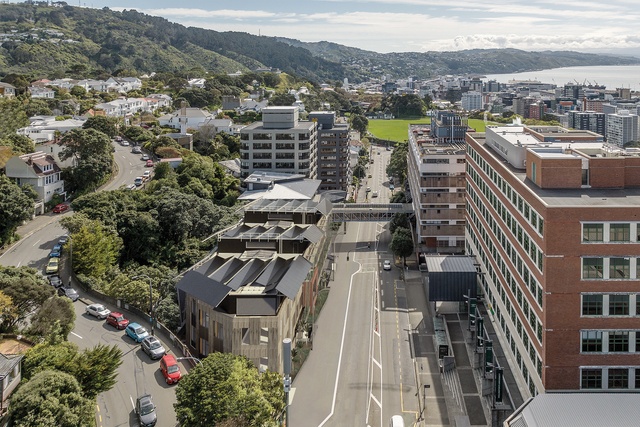
We’re not saying that this one building will provide all the answers in a single blinding insight. But, like every living building, it’s one step forward. And that’s how it should be. Throughout history, the advance of architecture has always been iterative and collaborative. Standard practice has always moved forward through a process of architects, builders, clients and suppliers working together, constantly learning, project by project, as we search to solve a shared problem.
Right now, our problem is the built environment’s shameful contribution to the global climate crisis. The life cycle of the world’s current stock of residential and commercial buildings is responsible for an estimated 40 per cent of global CO² emissions, and humanity will build the equivalent floor area of New York City every month between now and 2060.
“We need to understand that ‘embodied carbon’ emissions are just as problematic — that’s the carbon produced on the construction site, during the creation of the building materials and through to its eventual destruction.”
Up until recently, most of the focus on building greener buildings has been on the energy and water used to operate them — but advances in efficiency are slowing. We need to understand that ‘embodied carbon’ emissions are just as problematic — that’s the carbon produced on the construction site, during the creation of the building materials and through to its eventual destruction.
Working with the Living Building Challenge is driving our Tennent Brown team and our partners to challenge and rethink just about every industry-standard approach to building materials and construction. It’s a process we hope will contribute to the larger goal of changing standard practices throughout the industry.
A NATURAL FIT WITH A MĀORI WORLD VIEW
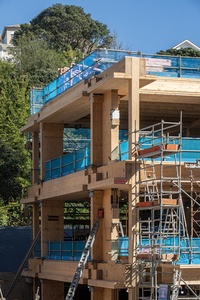
The Living Pā will stand alongside Te Tumu Herenga Waka, the university’s existing whare whakairo (carved meeting house). Built in 1986, it was a trailblazer. To have a distinctly Māori space with Māori symbols at an elite institution, Western in concept and setting, was extraordinary at that time (and remains so today).
Fast-forward 37 years and the Living Pā marks another milestone for the University’s marae. With a second opportunity to build a marae facility, the marae whānau is again looking to do something exceptional: another house that is the ideal, and where the lessons from generations past will combine with innovative new ways of learning, teaching and thinking about the future. One of the standout things about this project is the way Māori and Living Building Challenge philosophies align.
Manaakitanga (generosity and care) relates to supporting the well-being of communities, which is central to the Living Building imperatives, and kaitiakitanga (guardianship of the land) underpins all that we do. We have daylighted about 30 metres of the Kumutoto Stream headwaters located on this site as a way to connect to the stories of the site, the story of wai (water) and the surrounding area.
As an educational hub, the Living Pā features an airy, open-plan engagement space on the ground floor, teaching spaces on the second storey and staff accommodation at the top. And, in a space dedicated to learning, it feels all the more fitting that the building itself will also serve as a kaiako (teacher).
We want the Living Pā to be a building other clients and architects look at and think, “how could I do that on my own project?” In the future, we want it to be the building where people say: “that was the first time that particular thing was done and look how that idea expanded across the industry”.
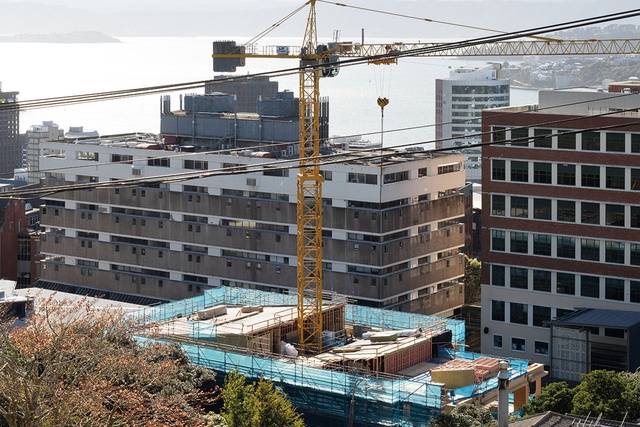
A JOURNEY UNDER WAY
The Living Pā is currently very busy on site, with a year to go until completion. It’s the fifth and most ambitious Living Building Challenge project on which we have worked at Tennent Brown (with a sixth in the offing).
The Living Pā’s honey-hued, mass-timber construction is already attracting a lot of attention from onlookers outside the site fence. Deeper within, the detail of the design and its self-sufficient features will set the building apart, including an onsite wastewater treatment plant saving more than 300,000 litres of potable water annually being used to flush toilets in the adjacent Murphy Building, and an extensive solar array supplying 105 per cent of its energy needs.
At its heart, the Living Pā speaks of past and future, tradition and innovation, trial and triumph. Anchored on a compact urban plot steeped in history and mana, it’s the sort of building that already means many things to many people. We are not just dealing with a new building but also supporting the existing wharenui and ātea (the open area in front of the wharenui) as well as the surrounding site, and its connections with the wider campus, the headwaters of the Kumutoto Stream and the local ecology. We’re thinking beyond just our building and site.
PROGRESS THROUGH MANY STEPS
Since joining forces in 2003, Hugh Tennent and I have put sustainability at the forefront of our practice. Creating buildings that minimise harm to the planet, connect harmoniously with the land they stand on, and improve the lives of the people that use them is central to what we do.

Working within the Living Building Challenge framework forces us to take that approach to the next level, even when completed buildings don’t become fully certified Living Buildings. Although the process of auditing and testing to achieve full certification is becoming easier, it is still complex and time consuming. And, in many cases, the certificate isn’t the point. Part of our learning process has been completing a number of buildings that incorporate many Living Building Challenge features but don’t have full certification.
Our first Living Building was a Ngāi Tūhoe project, Te Wharehou o Waikaremoana, a new visitor centre (Architecture NZ Sept/Oct 2017), which was developed in accordance with Living Building Challenge principles until part way through the design process. Tūhoe further demonstrated its commitment to the Living Building Challenge when Te Kura Whare was completed in 2014, becoming New Zealand’s first fully certified Living Building in 2017. Our second project to incorporate the framework, also for Tūhoe, was in Te Tii Hub in Ruatāhuna at the heart of Te Urewera.
In 2020, our third project, the new Tairāwhiti Gisborne Airport terminal building (Architecture NZ May/June 2022) delved even further into the Living Building principles, being tendered at Living Building Challenge level but not taking the final step. More recently, Pā Reo at Te Wānanga o Raukawa campus in Ōtaki (Architecture NZ Sept/ Oct 2023) marked our fourth Living Building project. Featuring a highly energy-efficient structure, water treatment zones and vegetative wetlands, it was completed in May 2023.

Pā Reo is set to achieve the fully certified Living Building status in late 2024, followed by the Living Pā in 2025. Once this happens, these buildings will be among just 32 others in the world currently to be fully Living Building certified.
For us, the real power in these projects is the ability to educate and inspire others about the merits of the framework. Subcontractor training sessions, presenting to suppliers and sharing our knowledge as much as possible have become major parts of our role as architects. We see this as key to achieving the goal of making more-sustainable construction part of the industry mainstream.
The Living Building Challenge isn’t just a concept, it’s a call to action, and I love seeing people getting excited about it. It’s cool to think that what we’re doing here competes with any other top international project, that little old Wellington or tiny Ōtaki are world-leading.
DECODING THE LIVING BUILDING CHALLENGE
Developed by Seattle’s International Living Future Institute, the Living Building Challenge is based on the idea of a building being like a flower, capturing all the water and light it needs, leaving no waste, living in balance with its environment and adding beauty to its surroundings. To translate the vision into tangible results, it outlines a range of demanding construction criteria under seven petals: place, water, energy, health and happiness, materials, equity and beauty.
“For me, it is the carbon component that has sparked my passion but it can be a difficult subject to understand and to teach others. How do we talk about carbon literacy, embodied carbon and life-cycle carbon modules in an interesting way?”
For me, it is the carbon component that has sparked my passion but it can be a difficult subject to understand and to teach others. How do we talk about carbon literacy, embodied carbon and life-cycle carbon modules in an interesting way? It’s not easy. But the results from these projects show we’re making a meaningful difference that can support carbon neutrality.
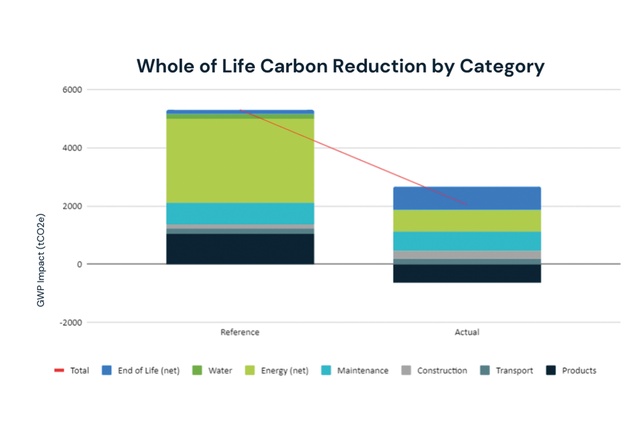
Constructed mainly from CLT and LVL, with virtually no steel or concrete, the Living Pā is a carbon sink. We have completed eTool life cycle assessments (LCAs) from the earliest design stages, to ensure carbon savings not only from the construction phase but over the entire life cycle of the building.
The carbon ratings for everything, from structural materials to the building envelope, services and internal walls, showed emissions of 421kgCO² e/m² over the building’s life (carbon modules A–D and a very detailed scope). To put it into perspective, this is lower than the 2030 targets set by the Royal Institute of British Architects (RIBA) for commercial structures, and evidence that this project is up with global best practice.

To achieve the standard required under the energy petal, the Living Pā’s 551-panel, 220kWp photovoltaic rooftop array will generate 105 per cent of the project’s energy needs.
The Living Building Challenge’s water petal requires a structure to have its own water system, independent of mains supply. The compact site of the Living Pā makes this a challenge. It has been solved by storing cleaned and filtered rainwater for drinking in underground tanks, while greywater from showers and washbasins is repurposed for toilet flushing and watering plants on elevated planters that form part of the building’s biophilic design.
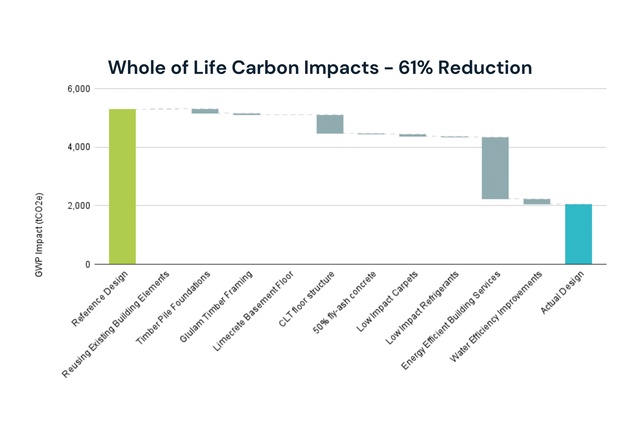
Aircraft-style vacuum toilets throughout the building represent another water-saving feature, using only 700ml of water per flush. Once wastewater is treated at the onsite plant, any excess is piped next door to flush the toilets of the adjacent Murphy Building.
The materials petal is perhaps the most demanding. It involves exhaustive research into the chemical composition of every product used in the build, to avoid the more than 800 CAS number chemicals on the Living Future Institute’s ‘Red List’. Included in the list is a range of suspected carcinogens and bioaccumulative substances. This not only challenges all consultants and suppliers to find Living Building compliant alternatives but, also, encourages materials suppliers to drop Red List chemicals from their products altogether. It’s satisfying to see a single project start to make changes in our supply chain.

The chemical transparency research really is a formidable task. This is another way our previous experience with Living Building Challenge projects pays off, as we continue to build up our list of compliant materials. It’s a change that runs through all our other non-Living Building projects. If you have found more healthy materials, why not use them on all projects?
We do have to navigate frequent roadblocks and it is always challenging. At the Living Pā, almost everything you see is an example of something we’re doing differently. But it’s invigorating as well. I’ve never worked on anything that has made as much difference in terms of environmental standards. So, you lean into the wins and keep going, because it’s the right thing to do.
As Nelson Mandela said, “it always feels impossible until it’s done” and, with all the challenges in achieving a full living building, it really feels like that at times. We have a short and critical period to do our best to mitigate climate change and I want to be able to look my kids in the eye and say I tried my best.
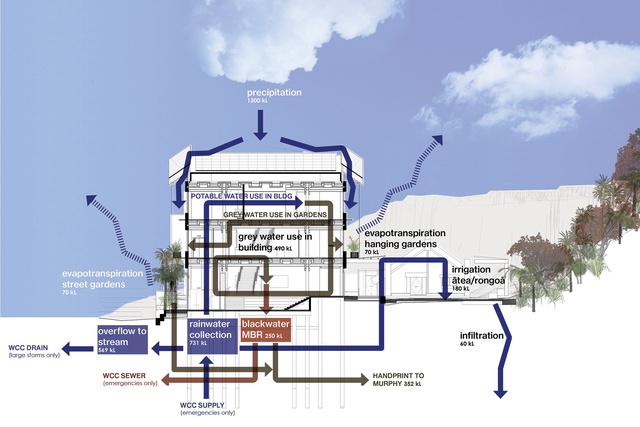
WHAT ARE LIVING BUILDINGS?
Living Buildings are structures that give back to the environment and the people who inhabit them through regenerative design.
Developed by the International Living Future Institute®, the Living Building Challenge® is organised into seven performance areas, or petals:
• Place – Restoring a healthy interrelationship with nature. Ecological restoration of site.
• Water – Embracing water independence and cultural significance.
• Energy – Enabling energy independence, powering sustainability and reducing carbon footprint.
• Health and happiness – Creating environments that optimise health and well-being. Manual control of air and temperature. Proximity to views and natural light.
• Materials – Driving low-toxicity materials and facing the challenge of chemical transparency. Proximity of materials to site and advocacy for healthier materials.
• Equity – Supporting a commitment to social justice by the team. ‘Just’ membership.
• Beauty and education – Celebrating design that uplifts the human spirit and incorporates human–nature interactions.
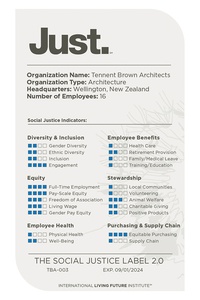
As part of the criteria for achieving Living Building certification, each building’s performance must be closely monitored and recorded for a year following completion. Currently, there are just 32 fully certified Living Buildings in the world.
Ewan Brown is a director of Tennent Brown Architects, based in central Wellington. Tennent Brown is the first certified B Corp architectural practice in the country and, since 2017, has been certified with the International Living Future Institute’s Just® label, a standard that rates companies across six socially responsible categories, including diversity, equity and worker benefits.


